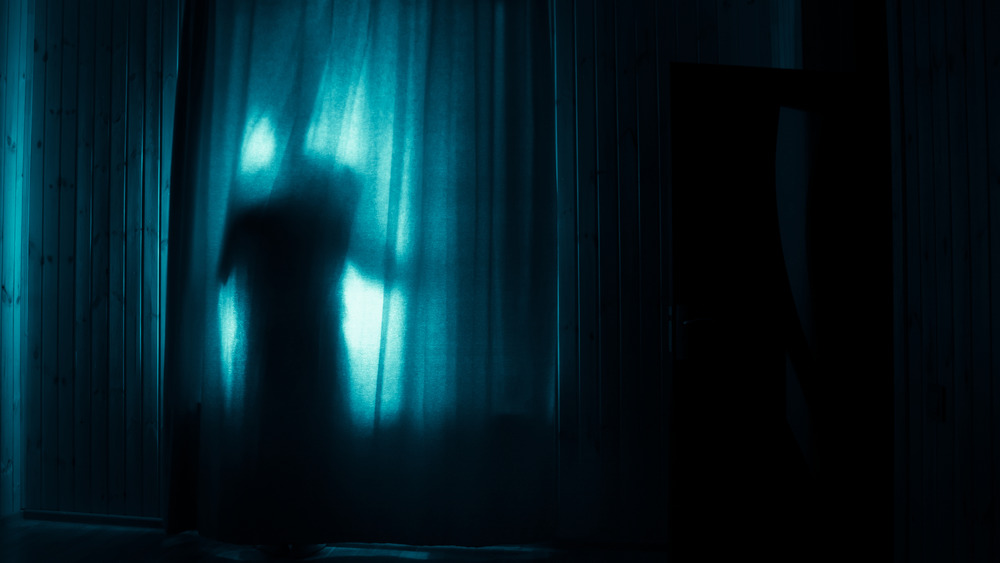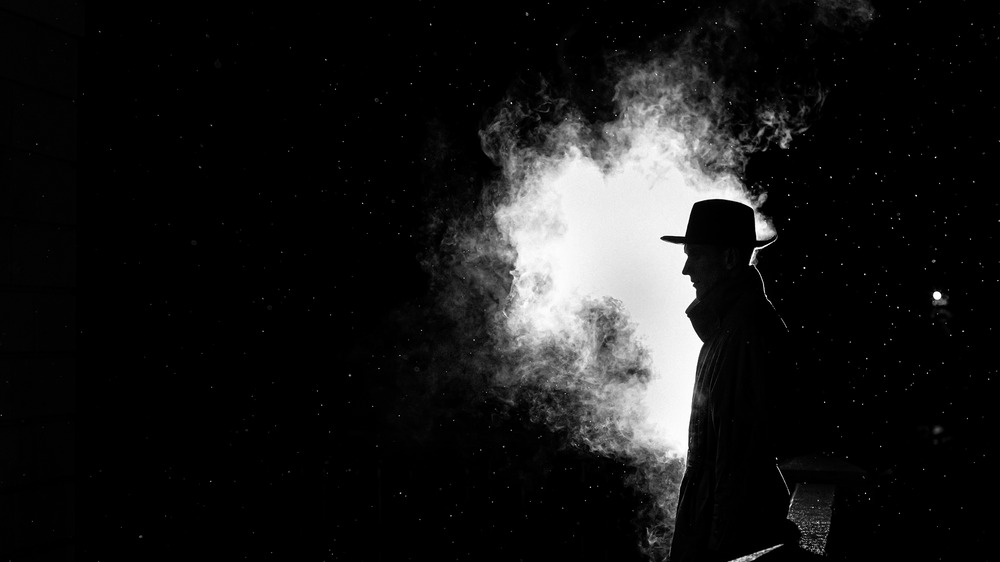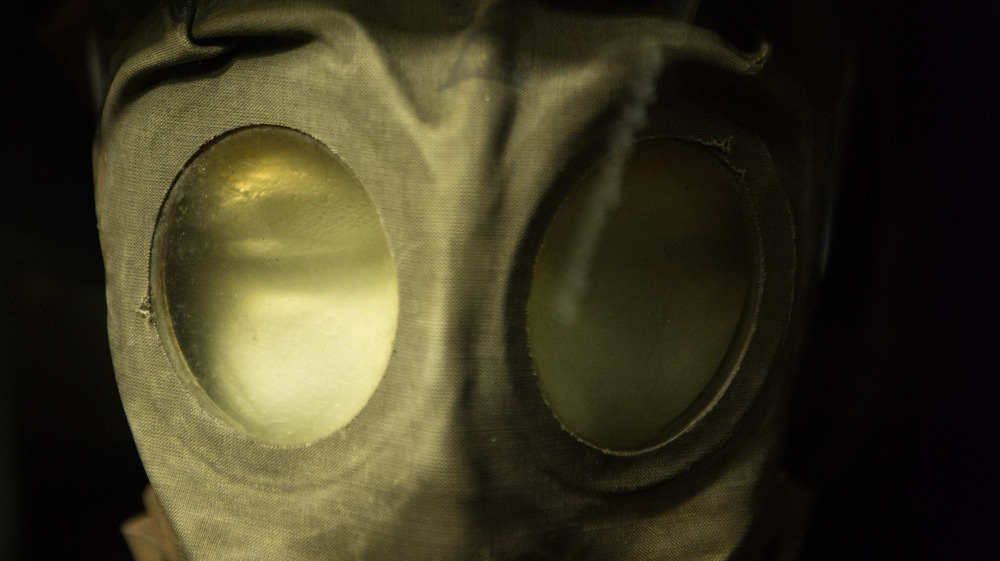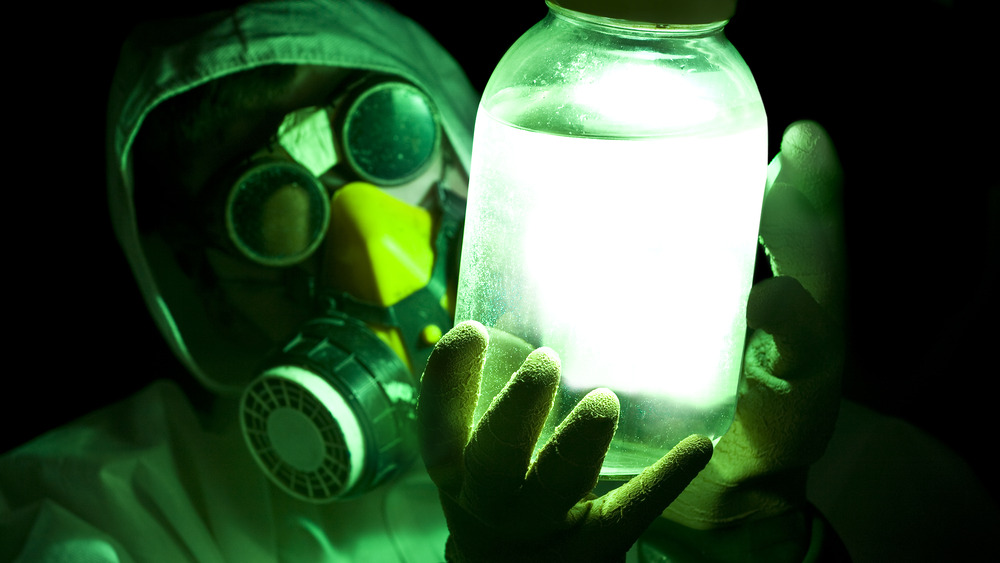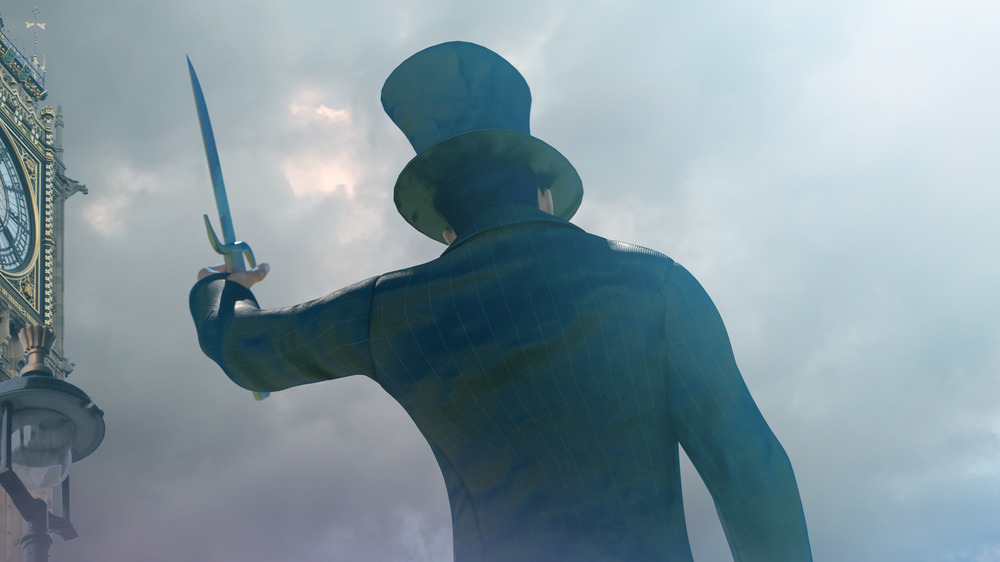What Was The Mad Gasser Of Mattoon? We Explain
The Mad Gasser of Mattoon is often cited as the premier case of mass hysteria — it is literally the textbook definition of it in some psychology courses. It is hard to blame the skeptics. What is an easier sell — someone (or thing) creeping up to windows in rural Illinois and spraying strangers with gas, or that people are spooking themselves and getting carried away?
According to the University of Illinois Library, for a few weeks in late summer 1944, upwards of 33 people experienced something strange (though not unprecedented). Instead of being, as the University of Illinois Library put it, the "alleged bagel capital of the country," Mattoon became known for a mass of gas attacks or, possibly, mass hysteria. (Mass hysteria about the gasser, not that easily debunked claim about bagels.)
At the very least, as Jon Downes stated in Fortean Times, "tales like those of the Mad Gasser of Mattoon are, quite simply, irresistible fun." Those who had seizures may not have heartily agreed with Downes' assessment.
Initial reports
The Illinois Times reported that people would wake to a "sweet cheap perfume odor" in their homes, sometimes accompanied by blue vapor. They would then suffer partial paralysis, nausea, or outright vomiting, some experiencing respiratory issues for hours. A couple spat up blood.
A few of the victims saw a figure running away from their homes, as well. They found footprints just outside their windows, many of which were cut and deformed as though something had been shoved through.
The Kearney family was the first recorded victims, the mother of which told the Mattoon Daily Journal-Gazette, "the odor grew stronger and I began to feel a paralysis in my legs and lower body" (via Belt Magazine). The title that the paper went with for the article? "Mrs. Kearney and her Daughter First Victims," which led to skepticism of the paper's precognitive powers. The headline meant that another family was attacked 20 minutes later, which was also explained in the paper. As History of Yesteryear noted, 97% of Mattoon subscribed to the paper, blanketing the town with the proposed facts of the story.
Other victims soon followed, all the symptoms similar — though some with increased severity, such as Beulah Cordes, who sniffed a cloth she found on her porch. According to Damn Interesting, she said, "... Soon my lips were swollen and the roof of my mouth and my throat burned. I began to spit blood ..." Well before people could have compared their experiences, their reports were uncomfortably alike.
The Mad Gasser him, her, or itself!
American Haunting Ink noted that the Gasser always was allegedly a thin person dressed all in black with a tight cap on their heads. They were usually described as a man, though there were a few reports where the witness was adamant that it was a woman instead — so much so that there were the prints of a high-heeled shoe outside windows and a dropped lipstick tube, reported Astonishing Legends. (One has to agree that, if one is escaping detection and might have to flee at a moment's notice, one should stick more to the practical than fashionable footwear, and leave the makeup at home.)
Aside from some confusion over gender, their description and behavior were identical. Regrettably, illustrations frequently give them a cape and wide-brimmed hat, along with an elephantine gas mask, as shown by Orangebean, rendering them something more like a super-villain Zorro. This description does not appear in reports but cuts a better figure for a myth. They never tried to physically confront any of their victims and ran whenever anyone spotted them. (As the people spotting them grew increasingly armed over the two weeks of the attacks, the latter was sensible.)
The newspapers had more exciting names for the gasser, such as the Phantom Anesthetist, but "Mad Gasser" stuck. Punchier and easier to spell.
Fear sells papers
The Mad Gasser was terrible for the citizens of Mattoon, who lived in fear that they would be struck next, whose paranoia redoubled every humid night they had to sleep with their windows tightly shut, according to the Fortean Times.
You know who the Gasser wasn't terrible for? Newspapers found this to be excellent copy and led to a series of sensational headlines like "Anesthetic Prowler on the Loose." Soon, reports from local papers attracted the attention of publications such as Newsweek and Time, according to Belt Magazine. Though the local government didn't want Mattoon known for these attacks (perhaps explaining the bagel boast), it was impossible to ignore all the attention.
Once the FBI rolled into town, the papers seemed to understand that they, perhaps, had gone too far, writes Astonishing Legends. They had not outright hoaxed the Gasser — no matter the cynicism about the case, no one suggested otherwise — but they capitalized off it. In doing so, they primed other people for the possibility they or their loved ones would be next to be gassed. In short, says Exemplore, they may have caused even more cases to be reported and, in publishing lurid articles about those, encouraged even more — actual or imagined.
Gas leak
According to the University of Illinois Library, on September 12, the local sheriff, C.E. Cole, released a statement that their investigation showed that there had never been a Gasser. People had been worrying over nothing. Instead, he claimed that a shifting wind had blanketed the town with carbon tetrachloride from the local chemical plant, Atlas Diesel Engine Co. However, as The Dark Histories Podcast noted, the State Department of Health even filed a report stating that the plant was not to blame.
See, it was just a toxic leak of a substance that paralyzed people and made them vomit. Totally harmless. Don't you feel silly for getting so worked up? (Cole may not have excelled at putting people at ease.)
The plant was not willing to be used as a scapegoat. According to Astonishing Legends, Atlas sensibly pointed out that there had been no such leak. The only gas in the plant was in their fire extinguishers, which were not defective. It did not make sense that gas only attacked people at night or that this supposed gas did not affect anyone working in the plant. Added to this, few known gasses will cut screens open with knives.
Putting the genie back in the bottle
Soon, the FBI decided to pay a visit to Mattoon. Possible Nazi testing chemicals out on unsuspecting Americans might be of concern.
The cases rose precipitously while they were there, with "armed citizens [taking] to the streets," writes American Hauntings Ink. Rumors abounded, and, according to The Illinois Times, Sheriff C.E. Cole said that they would consider reports of the attacks low priority going forward and threatened to "to arrest anyone else who reported a gassing without submitting to a medical examination."
Once the FBI cleared out, there were more reports. Cole arrested no one. Some who were attacked may have been too scared to alert the police, however.
According to History of Yesteryear, even when trying to assuage the populace that everything was fine, Commissioner of Public Health Thomas V. Wright stated, "There is no doubt that a gas maniac exists and has made a number of attacks. But many of the reported attacks are nothing more than hysteria. Fear of the gas man is entirely out of proportion to the menace of the relatively harmless gas he is spraying." This was not as reassuring as he might have meant it, as "gas maniac" does tend to be something of an inflammatory phrase.
Panic in the air
A week after the first reports, newspapers began to scale back their sensationalism and attributed the gassings to hysteria. How could one possibly believe that a shadowy figure skulked outside homes, spraying an unknown chemical into homes for inexplicable reasons? Simply because the newspapers declared that this was precisely what was happening?
These attacks occurred during the tail-end of World War II. Sons and husbands had been conscripted or volunteered for service. According to The Illinois Times, the thinking went that the citizens of Mattoon, fixated on war and the potential for a chemical attack, conjured up a Mad Gasser to externalize these fears. Belt Magazine stated that there had been reports of a Nazi on the loose nearby, having escaped from a prisoner-of-war camp in Peoria. Mixing the fear of their relations being gassed on the warfront with the notion that murderous Nazis could find them, and you could well end up with delusions of a Mad Gasser.
Robert Bartholomew, a history teacher at Botany Downs Secondary College and scholar on mass hysteria, doesn't think the Mad Gasser case is as rare as it may seem. "I wouldn't be surprised if it were to happen again," he said, according to Belt Magazine. "I'd be surprised if it did not happen again."
Misogyny
Tied to the accusation of town-wide hysteria was that this all was explicitly the fault of women, as all things were in those days. Women were easily scared, feeble-minded, and moping that their loved ones were punching the Germans out of France. Women made this all up for attention, revelling that they caused there to be armed mobs roaming the night, looking for a black-clad demon they made up. As with the Salem Witch Trials, it little mattered that people might be hurt or die because it livened up the place for a little while.
As the American Psychological Association put it at the time, "One woman's hysterical report of being gassed and paralyzed at night led to heightened suggestibility of many others."
You just couldn't trust women to legitimately report when a man had attacked them, evidently, since they were only ever doing it as a desperate ploy for male attention, explained American Hauntings Ink. That's why whenever one woman reported that they were attacked, other women appeared to confirm that it happened to them as well.
The Illinois Times noted that the overrepresentation of female victims makes statistical sense. Owing to the war, there was a higher concentration of women to be victims, and nothing more ought to be read into it.
Paranormal?
Fine, this theory would surface eventually. What if it was aliens? Could it be that some extraterrestrial beamed down to test a new device on the unsuspecting populace, something to facilitate future abductions? Jon Downes, writing for Fortean Times, stated that the Gasser was reported wearing "a strange metal helmet or mask." Isn't that almost proof enough of their extraterrestrial origin and not simply a precaution against an anesthetic gas?
The Gasser did seem to vanish into thin air when chased. Thin air or... another dimension? Yes, some (though not many) hold to the theory that the Gasser was not only a stranger to our world but our plane of existence. Instead, they were some sort of transdimensional tourist who thought the best use of their time was to gas people in their homes.
Or it was Bigfoot. Yes, Bigfoot has never been known to carry a gas tank or even have rudimentary chemical knowledge. He is not known for being thin or wearing a tight black cap. None of the reported footprints look anything like bare feet, let alone enormous feet. Who would even make a high-heeled shoe that could accommodate Bigfoot? Yet this is still a theory that people pass around, according to Fortean Times. As Exemplore put it, "Bigfoot had strayed from its natural habitat and somehow obtained a degree in organic chemistry."
We got him!
According to The Illinois Times, a science teacher, Scott Maruna, self-published a currently out-of-print book titled The Mad Gasser of Mattoon: Dispelling the Hysteria. In it, he places the blame for the gassings solely on the shoulders of Farley Llewellyn. Maruna's evidence is superficially appealing. Llewellyn was a former chemistry student at the University of Illinois. He had blown up a chemistry lab behind his parents' home, though exactly how he did this is not well covered. It seems not to have had any casualties. These are not the most robust pieces of evidence, however. Llewellyn was reportedly gay, which Maruna said the town blamed for this "diminishing sanity."
Not compelling enough? According to The Illinois Times, Llewellyn, a genius and a drunk, was so vexed that his hometown did not embrace him that he hatched a plan that he would gas the town to get his revenge. Maruna goes so far as to claim the gas was tetrachloroethane, which the EPA identifies as causing respiratory, gastrointestinal, and nervous system issues that could fit with the gas's effect.
This does seem like a thin motive, but it was enough that Llewellyn was put under police surveillance. He was then locked away in a sanitarium for the rest of his days.
Llewellyn was never charged, though the excuse given, according to Fortean Times, was that the town didn't want to besmirch the Llewellyn name since his father was a beloved philanthropist.
Contradictory evidence
As seems plain, this case is not without its contradictions. If the Gasser existed — which is uncertain — were they male or female? Or, as some have suggested, is the answer "both?" Were there two or more Gassers, allowing them to cover more ground?
Weighing the theory that this was all brought about by womanly fright, how can it be answered for the fact that some of the witnesses and victims were men? Were they just overwhelmed by their wives' and daughters' charisma?
As for Farley Llewellyn's proposed guilt, one need only hover over the gas he would have supposedly used and the fact that, unless Scott Maruna writes a sequel, no one claims that Llewelyn was one of Batman's rogues' gallery. Simply put, how did a graduate of the University of Illinois in the 1940s create a gas that could immobilize people then dissipate to nothing by the time the police arrived to investigate? In The Journal of Abnormal Psychology, Donald M. Johnson pointed out that no gas produces the exact effects attributed to the contents of the Gasser's flit gun. Llewellyn's lab was examined, and no such substance was found. It doesn't seem too much of a stretch to wonder if they threw the guy under the bus for a more straightforward resolution.
The new (old) Gasser
From 1933-1934, Botetourt County, Va., was plagued by the Evil Dead to Mattoon's Evil Dead 2 – same plot but played more seriously. Victims saw a black-clad figure creeping outside homes — described both as a man and a woman, down to the high-heeled shoes. Whole families were immobilized or sickened by a sweet-tasting gas. According to Legends of America, victim Alice Huffman became so ill that a physician had to administer artificial respiration to resuscitate her.
The media took an avid interest. The New York Times published the story, "Virginians Are Terrorized by Gas Thrower, Who Flees in Night After Making Victims Ill." And again, the newspapers had to walk it back to forestall further panic.
The police took it seriously until townsfolk formed a vigilante mob. Then it was mass hysteria. One officer stated that "some innocent person passing a house ... may be wounded or killed through nervousness," according to Outbreak! Dismissal was not universal. The local sheriff said, "No amount of imagination in the world would make people as ill as the Skaggs are."
The Virginia State Assembly passed a law that, if people were hurt, a gasser would be "deemed guilty of malicious wounding and punished with from between one and twenty years in the penitentiary ...," according to Outbreak! No one has ever been charged. The county Board of Supervisors offered a $500 reward for the arrest and conviction of the Gasser. No one collected.
Other related cases
Beyond Botetourt County, researchers have retroactively attributed the Mad Gasser to fanciful unsolved cases. None of them fit well, but one appreciates the idea that the Mad Gasser has so long a pedigree.
The most prominent of these was the Spring Heeled Jack in 1837. A figure would pop up at women's doors, spit fire at them, assault them, then jump away with fantastic leaps. This would make for a far better supervillain than the Gasser, though he may have only been a pervert who was strange enough to be enshrouded in urban legend and mass hysteria.
Another, sticking with the jumping theme, was Pérák, the Spring Man of Prague, who startled people by jumping out of alleys during the Nazi occupation, possibly wielding razor fingers, according to the British Library's European Studies Blog. Again, not quite the MO of the Gasser, who might not have wanted to make the commute but undoubtedly unsettling to the unwary.
Of course, the Mad Gasser reminds some of Jack the Ripper, according to The Chiseler. He was never conclusively identified and was possibly fabricated by newspapers to increase readership and the police so that they could say there was only one killer rather than many. Going from brutally murdering sex workers to spraying paralytic gas at families would be quite the de-escalation. Needless to say, none of these were Farley Llewellyn, on whom all things must be blamed.


